Definition: Forensic Physics deals with the use of scientific knowledge of physics in the investigation and adjudication of judicial laws (criminal and civil).
There are numerous examples where physics has been used to solve forensic cases. Yes! In fact, I will can you 100 examples, but for the sake of this article, I narrowed it down to a possible 15 main sections as the importance of forensic physics.
#1 Ballistic is itself a Physics

Ballistics uses physics in every aspect, from manufacturing to evidence comparison. Even all three subfields of Forensic ballistics such as internal, external, and terminal ballistic use physics as a substrate for building their working theories. There are many questions that only is answered through physics.
#2 From Where Bullet Comes & Possible Path

To leave the earth’s gravitational pull, at least 7 miles per second is required. This can’t be possible for a bullet. So, they will fall to the ground (and this is called bullet drop).
This is all majorly governed by the propulsion power of gunpowder and the aerodynamics of the projectile. More energy father it goes, and with friction in the air, it slows down and eventually falls.
So, by considering these factors, and the direction of bullet travel, forensic experts can try to identify from where a bullet was fired and its path.
#3 Which Gun is Used for Crime
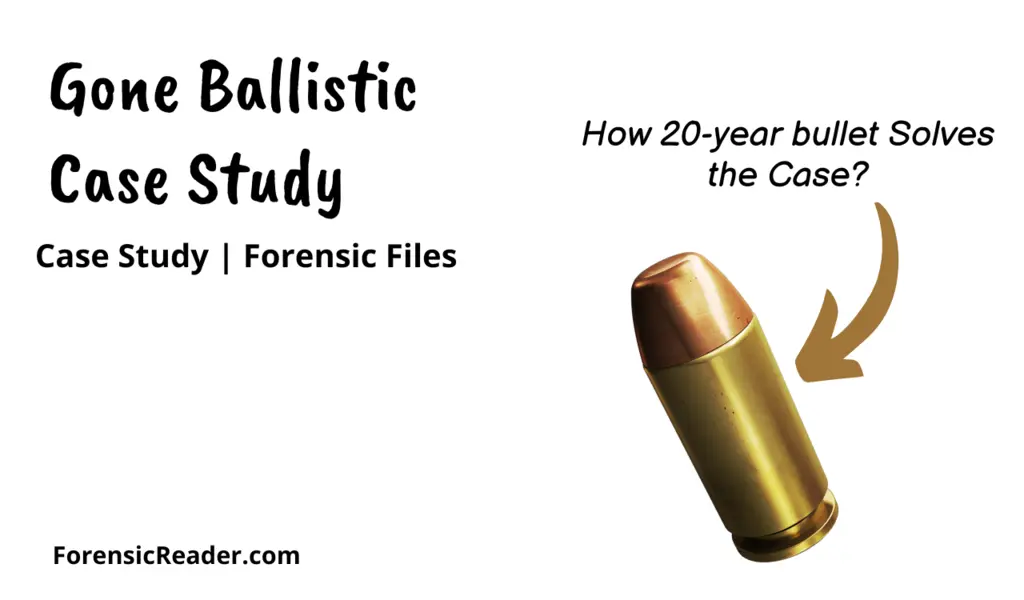
Lands and grooves– the most characteristic feature of the bullet.
Each fired bullet has lands (raised edges) and groves marking from the rifled barrels. This not imparts the spin (for gyroscopic stability) and is unique. This also provides a comparing benchmark for forensic experts.
While comparison, three main features:
- Width of lands and grooves, and
- The angle of twist of rifling
- Type of twist (right-hand or left-handed)
#4 Calculating How much Bullet Spins (Rate of Twist)?
A. For bullets with a specific gravity of 10.9:
- Rifling Twist Rate Required (SP =10.9) = 150 x D2/L
- Where D = bullet diameter in inches and L = bullet length in inches.
B. For bullets with specific gravity other than 10.9:
- Rifling Twist Rate Required= CD2/L x √(SG/10.9)
- Example: Twist rate required for .22” caliber is 1 in 24”
#5 Force With a Projectile Hit the Target and Recoil
When there is an action of propulsion of bullet there is an equal and opposite reaction that set firer back. That we called recoil velocity and the force/velocity of impact back to firer is called terminal velocity.
Here, physics comes in handy. Experts can determine the recoil velocity using the formula
V= mv/M,
- where, m and M are the masses of the bullet and gun respectively.
- v and V are the velocities of the bullet and gun respectively.
#6 The Blood Spatter: A Bag of Evidence
Every aspect of blood spatter involves physics: from the drop angle to the position victim. A careful examination and a bit of experience can make a blood spatter a good piece of evidence.
A. Position/Movement
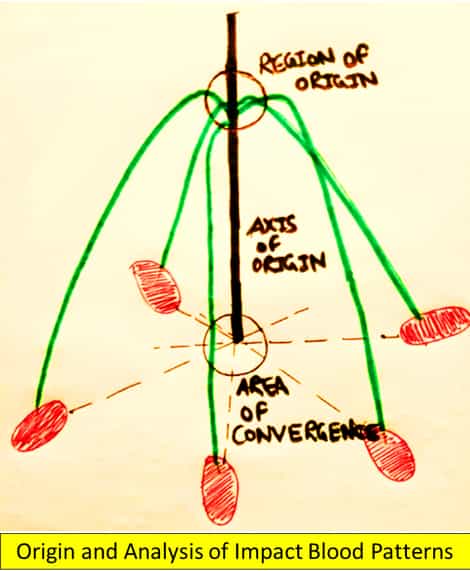
With it, the positions of the victim, assailant, and objects at the scene. This helps in defining:
- The probable height of the victim and assailant.
- Their position on the scene.
- Whether the body is moved.
- Whether the object is moved or missing from the crime scene.
B. Types of Weapon/ Wounding
Forensic physics also helps in determining:
- What causes it? (Types of weapon)
- Number of blows, shots, stabs, etc. (single or multiple spatters)
- High-velocity or low-velocity spatter
C. The Impact Energy and Spatter
The impact energy mainly pronounced the type of weapon that causes spatter. Basically, there are three types: high, medium, and low.
Fact: As the impact energy increases, the size of droplets decreases.
Thus, the impact velocity can be determined by examining the size and number of droplets.
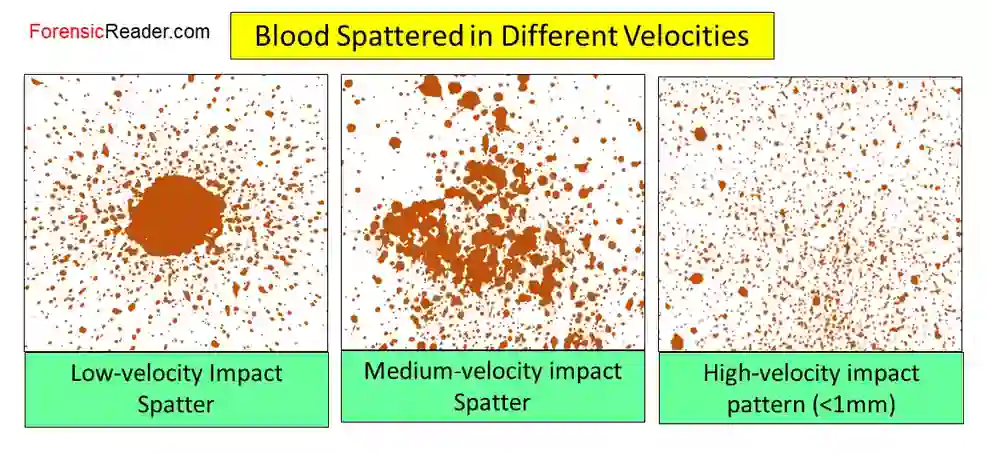
Other factors such as the effect of gravity, path of flight, and surface tension can also reveal good information about the position of the attacker.
D. Sequence of Event: Reconstruction
With all in hand, forensic experts can predict a possible sequence of events by understanding how the to spatter might occur.
#7 When You Put Brakes on? Skid Marks
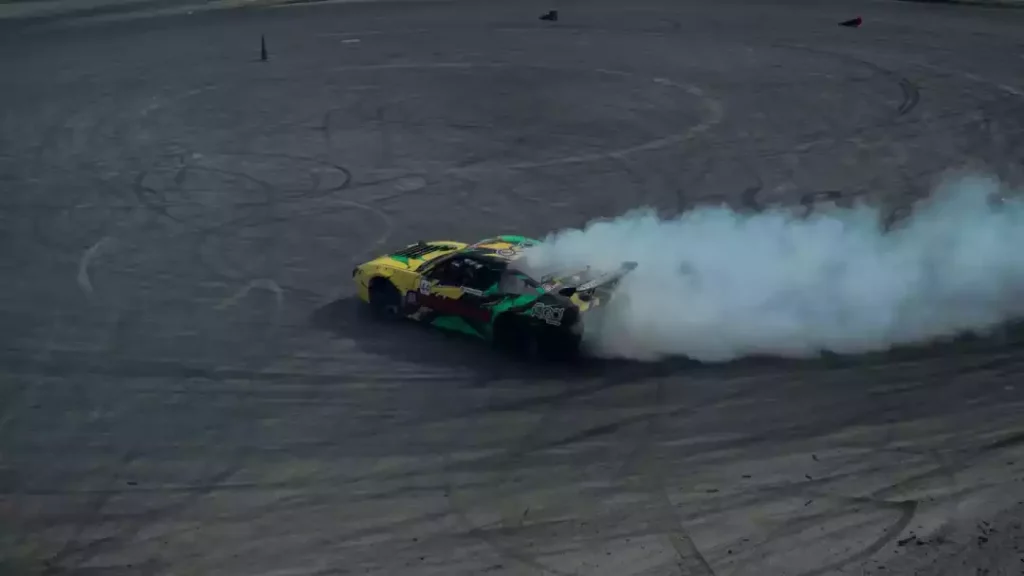
To determine when the brakes were pushed, a forensic expert needs the measure the length of skid marks by tires.
With the help of forensic physics, the skid marks can help in determining the speed, range of friction, and force applied while applying the breaks.
It can be calculated with the formula:
Speed (mph)= √(30 x D x f)
- S is the speed of the car (in mph).
- d is the distance the car skidded in feet.
- f is the coefficient of friction; The value of f is 1.0 for dry tar, and 0.5 for wet tar.
Example: Calculate the speed of the vehicle whose skid mark length is 20 feet and coefficient of friction is 1.0.
Solution: √(30 x 20 x 1)= 24.49 miles/hr.
#8 Searching for Explosion Parameter
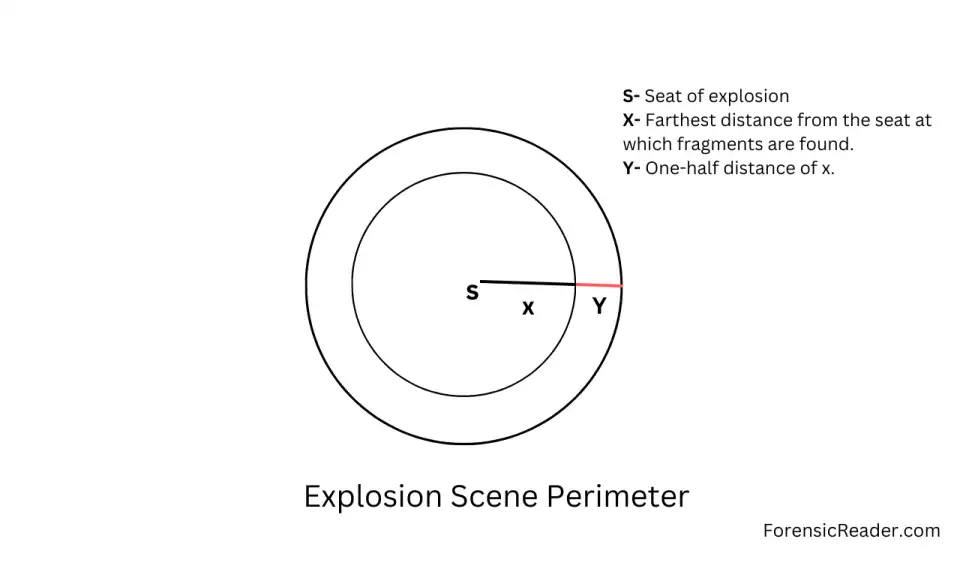
By using forensic physics, the radius of the blast area, and point of origin can be determined to find more debris and evidence for analysis.
Calculation of Explosion Scene Parameters for search:
Formula for Explosion scene perimeter= x + y (which is 1.5x)
If the blast took place in an open space with a:
- x= farthest distance from the seat at which fragments are found
- y= half the distance of x
#9 The Shock Wave Chemistry in Physics
Forensic physics helps in calculating the approximate energy released by the blast pertaining to the shockwave.
An explosion can create a huge amount of gas that can travel at a speed of about 7000 miles per hour. This shock wave or “blast effect” is more damaging up to a certain radius.
Defining the site of origin:
- Damages to filled organs can define the position of the person at the site of the explosion seat.
- Damages to walls and nearby object help in defining the point of origin.
So, where is the physics? Based on these damages, a forensic expert can calculate the minimum amount of explosive material used in making it.
Note: However, the amount also varies with the type of explosive materials used in making.
#10 Physics in Analysis of Glass Evidence
The density gradient and Becke Line immersion method is the most used method for comparing the glass evidence.
A. Density Gradient Method
This method uses to compare two or more sets of glass using flotation level. Bromoform and bromobenzene are two liquids used in this method.
These liquids have different densities and are mixed in proportion.
- Top layer is low-density liquid, bromobenzene (1.49 g/mL).
- Bottom layer is a high-density liquid, bromoform (2.87 g/mL).
Example: If two pieces originated from the same glass plane, they float at the same level.
B. Beckeline Immersion Method
The refractive indices of glass fragments can be determined using this method.
Process: On immersion of glass fragment in a liquid whose RI:
- Beckeline appears: When the Becke line appears inside the edge of a glass fragment, this means the glass piece has a greater RI than the surrounding liquid.
- Beckeline Disappears: When the RI of glass is equal to the surrounding liquid, then the glass should invisible.
Note: More Advance Method GRIM: Full form— Glass Refractive Index Measurement in which temperature variation is used to measure the refractive index of glass. Foster and Freeman developed it in the mid-1980s.
#11 Microscopes and Forensic Evidence
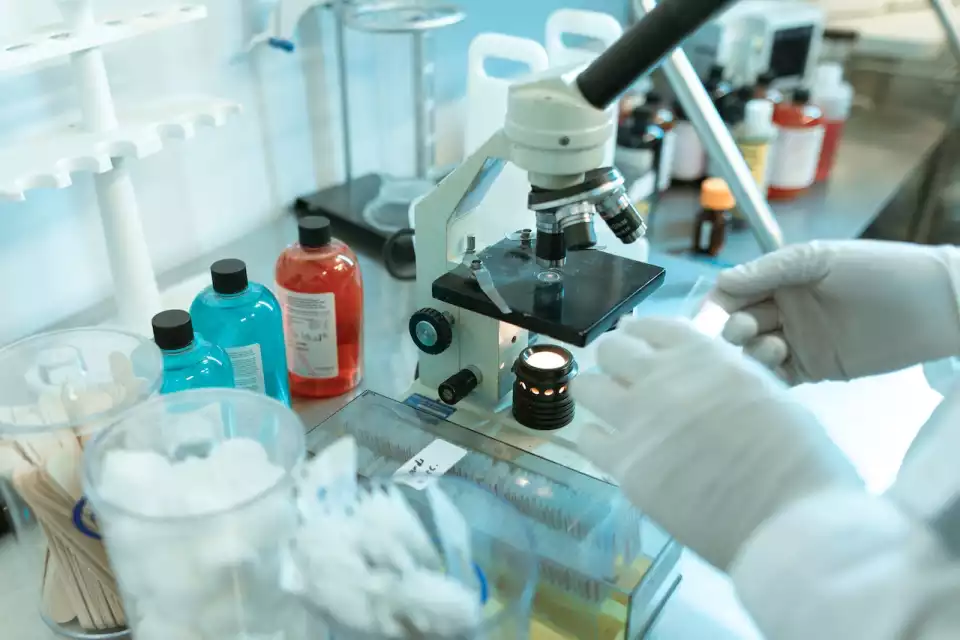
Microscopic features give more characteristics feature to individualize a sample to a specific group. The most common one is the standard microscope, others are:
A. SEM (coupled with X-ray analyzer)
- They are used for the elemental analysis of paint chips, jewelry, stones, fibers, and GSR.
- Principle: Each element emits X-rays of characteristic energy values identified by an X-ray analyzer to identify the elements present in a specimen.
B. Comparison Microscope
- Provides two sets of views that can be compared side by side.
- Commonly used for the visual comparison of the color of paint, fiber, and ink evidence, and characteristic features of bullets.
C. Infrared Microspectrophotometer
- Used for the elemental analysis of forensic evidence such as fibers, paint chips, GSR, etc.
- Principle: The IR spectrum is also called fingerprint region because it is unique for each chemical substance.
D. Polarizing Microscopy
- Widely used for the examination of birefringent minerals present in the soil, and comparison of glass and fibers.
- Process: When evidence is placed in polarized light, it produces vivid colors and intensity contrast that provides a very distinguishable feature even between slightly different shades.
- For example: If there are multiple sets of the same shade of clothing worn by different people. But with time, their shades fade based on environmental factors and washing wear. This changes the shades of clothing and these shades can be easily distinguishable using a polarizing microscope.
#12 Toolmarks Database: TRAX
Tool marks are mainly compared side-by-side first by making a cast and then using a comparison microscope but there are also databases of tool marks. One such one is Tool Mark Imaging System Database (TRAX).
The database is filled with video images and alphanumeric data about the various characteristics made by tool marks such as the tool angle, the material used, and striation marks made by specific types of tools.
For striation mark detection, the system uses an adaptive zoom algorithm for extracting striation features. Read More at Researchgate.
#13 Forensic Engineering and Physics
Nearly every aspect of forensic engineering uses physics. In practice, it includes the concepts of mechanical, chemical, civil, and electrical engineering for determining the cause of an accident.
A. Traffic Accidents
Mostly used in traffic accident cases to depict the answer such as:
- Skid marks
- Damages to cars
- Position of the car before and after an accident
- Road condition
B. Other Accidents Cases
- Premature structural failure (concrete and mortar analysis)
- Aircraft crashes or marine incidents.
- High power electric lines failure.
#14. Jumping from Height
In any case of jumping from a height, the first question arises whether that individual fell accidentally/intentionally or someone threw them off.
For, forensic physics is very helpful. The angle of impact, the blood spatter at the ground, which body part hits the ground first, the face of the body, distance from the building, etc. help in the reconstruction phase and can reveal the truth behind jumping.
#15 Other Instruments Made Possible by Physics
A. Soil Analysis
Soil analysis is related to soil, rock, or mineral samples taken from any item such as shoes, clothes, or vehicles present in any crime scene with a specific location.
For this, some methods like – X-ray Diffraction, DRIFT method, and Mass and Volume Magnetic Susceptibility methods are used.
B. Facial Reconstruction
Forensic facial reconstructions from human remains are worn on software that uses physics equations. Some of the 3D facial reconstruction softwares are Computer Modeling and FaceGen.
C. Forensic Document Examination
Instruments such as IR, UV, Raman spectrometry, and Video Spectral Comparator (VSC) use the light spectrum to identify important clues from a document.
References:
- 3 Databases of Tool marks [Researchgate]
- FORENSIC SCIENCE From the CRIME SCENE to the CRIME LAB by Richard Saferstein [Book]
- Fundamentals of Forensic Science by J. A. Seigel [Book]
- Solving Crimes with Physics by William Hunter [Book]
- Fundamental Physics used in Forensics [Researchgate]
Read More:
- Forensic Analysis of Paper: An Informative Guide to Paper Forensic
- Forensic Mathematics: A Newer Approach to Forensics
- 21+ Forensic Questioned Document Instruments And Tools With Uses

FR Author Group at ForensicReader is a team of Forensic experts and scholars having B.Sc, M.Sc, or Doctorate( Ph.D.) degrees in Forensic Science. We published on topics on fingerprints, questioned documents, forensic medicine, toxicology, physical evidence, and related case studies. Know More.
